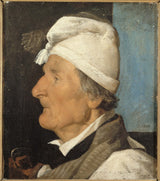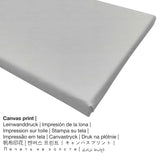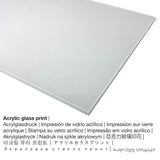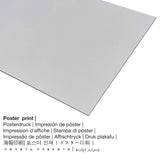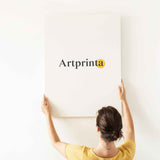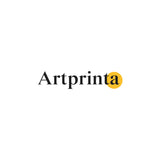Jean-Jacques Henner, 1845 - ọkwá nkà - ọmarịcha nka
Ụtụ gụnyere. Mbupu gbakọrọ na ndenye ọpụpụ.
Ozi zuru ezu na akụkọ
The 19th narị afọ ọrụ nka Ọkwá nkà Jean-Jacques Henner sere ya in 1845. A na-ese ihe nka na nha: Ogologo: 45 cm, obosara: 36 cm e tekwara ya na ọkara Mmanụ, Canvas (ihe). The original artwork's inscription is: "Signature - Bottom right: "J. J. Henner"". Today, the work of art is included in the Petit Palais - Musée des Beaux-arts de la Ville de Paris's collection, which is an art museum in the 8th arrondissement. This public domain piece of art is being supplied, courtesy of Petit Palais Paris.The creditline of the artwork is: . On top of that, alignment is Eserese ma nwee oke akụkụ nke 1: 1.2, nke pụtara na ogologo bụ 20% mkpụmkpụ karịa obosara.
Nkọwa ihe osise sitere na ihe ngosi nka (© - nke Petit Palais dere - Musée des Beaux-arts de la Ville de Paris - Petit Palais - Musée des Beaux-arts de la Ville de Paris)
The carpenter Bernwiller, Johann Hermann is shown in profile, wearing a white cotton cap, a plane is represented by him.
This carpenter portrait of the birthplace of Jean-Jacques Henner is considered one of the first paintings of the artist. He kept it in his studio until the end of his life.
Hermann, Jean
Portrait, Carpenter, Craftsman, Old man, Hat, Rabot
Tebụl a haziri ahazi nke ihe osise
| Aha nke eserese ahụ: | "Carpenter" |
| Nhazi nka: | sere |
| Category: | nkà nke oge a |
| oge: | 19th narị afọ |
| Afọ okike: | 1845 |
| Ogologo afọ nka nka: | ihe karịrị 170 afọ |
| Ọkara nke ihe osise izizi: | Mmanụ, Canvas (ihe) |
| Nha izizi (ọrụ nka): | Ogologo: 45 cm, obosara: 36 cm |
| mbinye aka izizi nka: | mbinye aka - N'ala aka nri: "JJ Henner" |
| Egosiputara na: | Petit Palais - Musée des Beaux-arts de la Ville de Paris |
| Ebe ngosi nka: | Paris, France |
| Weebụsaịtị ihe ngosi nka: | Petit Palais - Musée des Beaux-arts de la Ville de Paris |
| Licensedị ikike: | ngalaba ọha |
| Site n'aka: | Petit Palais Paris |
Nkọwa onye nka
| Aha onye nka: | Jean-Jacques Henner |
| okike onye nka: | nwoke |
| Nationality: | French |
| Ọrụ: | onye na-ese ihe |
| Country: | France |
| Nkewa onye nka: | omenkà nke oge a |
| Nwụrụ anwụ: | 76 afọ |
| Afọ amụrụ: | 1829 |
| Nwuru: | 1905 |
Ngwa ngwaahịa ị nwere ike isi na ya were
Anyị na-enye ụdị nha na ihe dị iche iche maka ngwaahịa ọ bụla. Nhọrọ ndị a dị maka n'otu n'otu:
- Mbipụta iko acrylic na-egbuke egbuke (ya na mkpuchi iko n'ezie): A glossy acrylic glass print, which is sometimes referred to as a fine art print on plexiglass, changes the original artwork into marvellous home decoration. Beyond that, it offers a good alternative option to canvas or dibond fine art prints. Your favorite work of art will be custom-made with state-of-the-art UV print machines. The major upside of a plexiglass print is that contrasts and also image details become identifiable with the help of the granular gradation of the picture.
- Mbipụta kwaaji: The canvas print is a printed cotton canvas stretched on a wooden frame. A canvas generates the unique look of three-dimensionality. How do I hang a canvas print on the wall? A canvas print has the advantage of being low in weight, which means that it is easy to hang your Canvas print without the support of additional wall-mounts. That is why, canvas prints are suitable for any kind of wall.
- Mbipụta nke aluminom: An Aluminium Dibond print is a print with a true effect of depth. A direct Direct Print on Aluminum Dibond is your best introduction to fine art reproductions with aluminum. Colors are vivid and luminous in the highest definition, the details of the print are crisp, and there’s a matte appearance you can literally feel.
- Mbipụta akwụkwọ mmado (akwa akwa akwa): A poster is a UV printed canvas paper with a slightly rough surface texture. A poster print is particularly designed for framing the fine art print in a personal frame. Please keep in mind, that depending on the size of the canvas poster print we add a white margin 2 - 6cm round about the print, which facilitates the framing with your custom frame.
Nkọwa ihe ahaziri ahazi
| Nkewa bipụta: | nka nka |
| Usoro mmeghari: | dijitalụ mmeputakwa |
| Usoro nhazi: | mbipụta dijitalụ (Mbipụta UV ozugbo) |
| Mmalite ngwaahịa: | German mere |
| Stockdị ngwaahịa: | a na-achọ |
| Eji ngwaahịa emebere: | ihe ndozi mgbidi, ihe ndozi ụlọ |
| Nhazi: | usoro eserese |
| Njikwa oyiyi: | 1: 1.2 (ogologo: obosara) |
| Ntụgharị nkọwa akụkụ akụkụ: | ogologo bụ 20% mkpụmkpụ karịa obosara |
| Ngwa ngwaahịa dị: | acrylic glass print (nwere ezigbo mkpuchi iko), mbipụta akwụkwọ mmado (akwụkwọ kwaaji), mbipụta ọla (aluminium dibond), mbipụta akwụkwọ. |
| Kanvas n'elu etiti ihe ndọtị (mbipụta akwa akwa): | 50x60cm - 20x24", 100x120cm - 39x47", 150x180cm - 59x71" |
| Mpempe iko acrylic (nwere ezigbo mkpuchi iko) nha dị iche iche: | 50x60cm - 20x24", 100x120cm - 39x47", 150x180cm - 59x71" |
| Nhọrọ nha nke akwụkwọ mmado (akwụkwọ kwaaji): | 50x60cm - 20x24", 100x120cm - 39x47" |
| Mpempe akwụkwọ Dibony (ihe alumnium) nha: | 50x60cm - 20x24", 100x120cm - 39x47" |
| Igwe onyonyo: | biko mara na emebeghi ngwaahịa a |
Nkwupụta iwu: We try the best we can to describe the products as precisely as possible and to illustrate them visually. Please keep in mind that the pigments of the printed materials and the imprint might differ marginally from the image on your device's screen. Depending on your screen settings and the nature of the surface, color pigments can unfortunately not be printed 100% realistically. Since all fine art prints are processed and printed manually, there may as well be slight deviations in the size and exact position of the motif.
© Nwebiisinka nke, Artprinta.com

